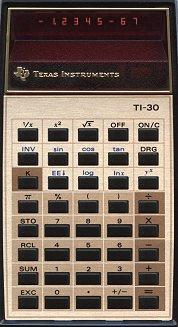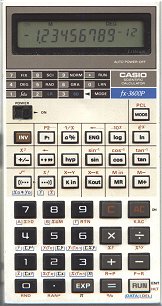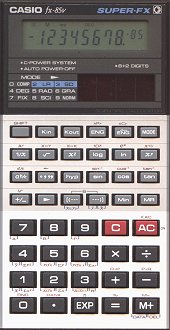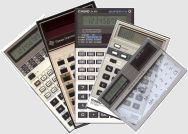Three calculators are finished till now. They imitate the
originals in nearly all details. Even the key click or automatic
power off if there is no input for some minutes (you may
disable these features in a configuration dialog of course).

Picture 1: Almetare calculators on KDE desktop
But, the algorithms of the calculators are not copied; in this point I rely completely on the compiler's mathematical library (I don't call the calculators "emulators" therefore). That means especially that the virtual calculators compute with better accuracy (about 15 digits) than the originals (8 to 12 digits). But, the user should not notice that.
The sources are published under the GNU GPL. You can get the sources and the binaries from the download page.
Texas Instruments TI-30The TI-30 was the calculator in German schools in the end of the seventies of the last century. You could not read its red LED display quite well (must look in the exact angle through the little magnifier lenses in front of the tiny digits) and it needed much battery power. One could really watch it doing its calculations: Thinking on "sophisticated" tasks, as sine or cosine, could take about a second, and the calculator enjoyed its impatient owner with interesting blinking effects in this time (to imitate this spectacle has cost quite a lot effort). Getting older the keys became bouncing; besides that the calculator managed its tasks because of its clear arrangement very good. The calculator cost about 30,- DM if ordered collective, as far as I can remember, and was worth its money. |
 Download |
Casio fx-3600PAlthough not very much younger (bought in 1982 for 89,- DM) the fx-3600P belonged to a complete other generation of calculators compared to the TI-30: 10-digit LC display (plus two digits for the exponent), seven independent (non volatile) memories, a lot of more functions (statistical, regressional, integral calculations), keyboard a little spongy but quite usable (and first of all absolutely free of bouncing) outpaced the TI. And the most important thing: the calculator has been programmable! Though the program memory could hold only 38 "program steps" you could do more with it than you might imagine. To me this has been the first step into the world of programming. The only thing I had missed was the conversion of numbers in different number systems. Especially to mention is its unbelievable low power consumption. I have really the first battery in it!The Almetare calculator can store an arbitrary number of program steps and save the programs to a file. Additionally there is a simple program editor and an editor for entering values in statistical calculations. |
 Download |
Casio fx-85vThis calculator was bought in 1992 and is in my possession as a loan. Its functionality and operating is like the fx-3600P, but it is not programmable, there are no integral calculations and the keyboard is a rubber pad. It is solar powered, to save the constant memories and for operation in faint light there is also a battery.Besides the TI-30 this is the second Almetare calculator. |
 Download |
Links
- www.calcinfo.com:
Mike Sebastian's site contains much technical information on calculators of various manufacturers, testing functions to figure out the chip and more. - www.datamath.org:
Very detailed site especially about Texas Instruments and its pocket calculators by Jörg Wörner. - www.rskey.org:
Special site about programmable calculators of various manufacturers by Viktor T. Toth (thanks for his help finding some bugs in versions 0.96 and 0.97!). - www.anita-simulators.org.uk:
Calculator simulators of the British trade name "Anita".



